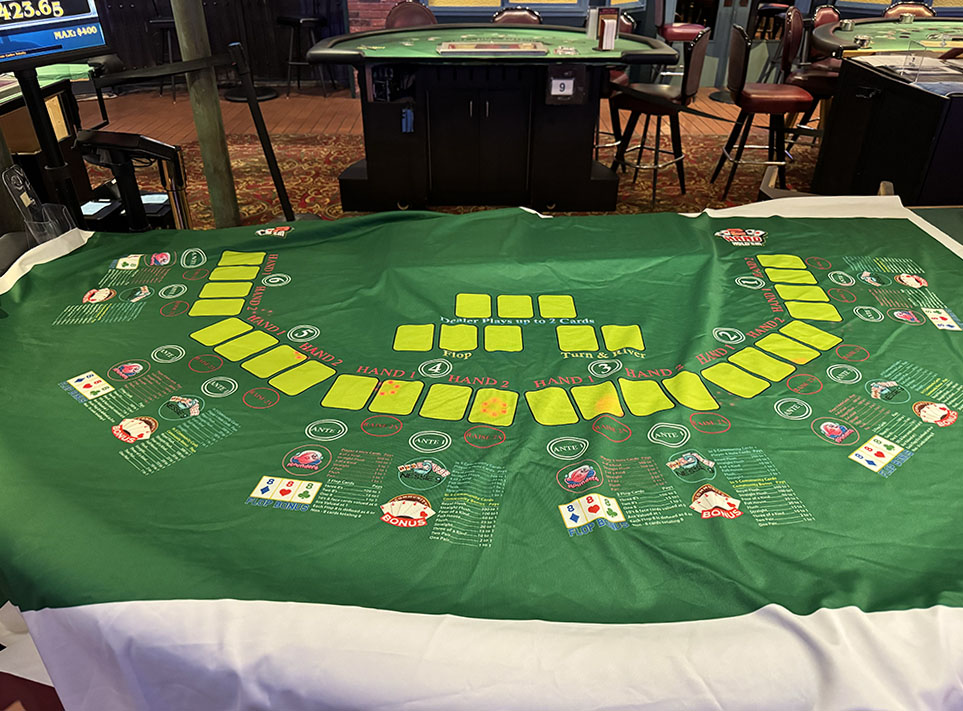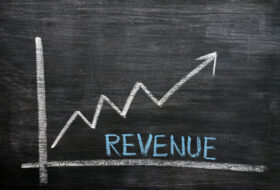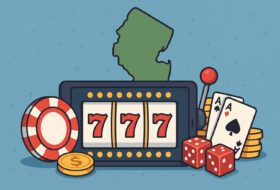
Two-Hand Hold’em is the latest table game to hit casino floors in Washington State, asking players to figure out how best to split four cards into two hands while giving each hand the best shot of beating the dealer. The mind behind the new game is none other than Wayne “D22-soso” Chiang, whose claim to fame could be his status as a StarCraft World Champion, his prowess as a professional poker player, his entrepreneurship, or even his role as producer of several popular poker streams, depending on who you ask.
Bonus had a chance to speak with Chiang about his new game and the twists and turns taken to get to this moment.
The first real-money hands of Two-Hand Hold’em will be dealt on December 27 at The Great American Casino in Tukwila, Washington. A roll-out at other Maverick Gaming-owned locations is expected soon, pending the game’s performance, and an online casino version may be coming at some point down the road.
Chiang was an early adopter of esports, gaining the number one rank in Command & Conquer and Warcraft, real-time strategy precursors to the global phenomenon of StarCraft. He proceeded to win the first World Championship of StarCraft but laments that it coincided with the dot-com crash, which proved to be a big setback for esports.
After that, in the early 2000s, he decided to go to college and prepare for a non-gaming career. Even so, he ended up playing poker professionally to pay the bills, because good student jobs were hard to find. That set the stage for his later involvement in poker streams and the development of Two-Hand Hold’em.
But first, what is this game anyway?
How to Play Two-Hand Hold’em
Like many casino poker games, the objective in Two-Hand Hold’em is for the player’s hand to beat the dealer’s, after some community cards are dealt. There’s also a single betting decision to be made mid-hand, where the player can optionally increase the stakes after seeing the initial deal.
The player receives four cards face-up, while the dealer receives three cards face-down. There are also three community cards (the flop) visible to start the hand.
The player’s bet is split evenly in two, as they will be playing two separate hands against the dealer. The first decision is how to split the player’s four cards into two hands, based on what community cards are available.
After that, the player has the option to raise with either or both hands. The optional increase in stakes is fixed at twice the original bet. So, if the player started with a $100 bet on each hand ($200 total), they could choose from the following:
- Check, sticking with with the original $200 total bet.
- Raise one hand to $300, for a $400 total bet
- Raise both hands to $300, for a $600 total bet
Then, the dealer reveals two more community cards and his hand. Each of the player’s hands and the dealer’s hand are then combined with the five community cards to produce the best five-card poker hand possible. For each of the player’s hands that beat the dealer, they receive an even-money payout.
Two-Hand Hold’em Side Bets
There are also three side bets the player can make. These have no decision-making but can pay out up to 500-1 based on the combination of cards in the player’s hand and community cards.
- 888 Flop Bet: Looking for 8s or cards adding up to 8 in the initial three community cards. (888 pays 100-1)
- Flounder 4: Looking for high-value combinations of cards just in the player’s initial four cards. (Four of a Kind pays 500-1)
- Nessie 9: Looking for high-value combinations of cards in the player’s four cards plus the five community cards. (Royal Flush pays 200-1)
If you’re curious, you can play Two-Hand Hold’em for free online.
Wayne Chiang on Two-Hand Hold’em
Q: How did you end up making the transition from esports and professional poker to casino game design?
In 2015, I was working with Jay Severson, the co-founder of Chess.com. He also had another site called Gambit.com and he was like, “Oh, if you want to design games, then we could potentially put them on there.”
And my first game was called Chains. It was okay, it wasn’t bad, but I knew I could do better. So I just sat down and designed, I don’t know, at least 25 card games and one of them was Two-Hand Hold’em. And I immediately knew would be a hit as a casino game, and most of my close network that saw it pretty much agreed. So I went through the patent process and just kind of went “all-in.”
I decided to go brick-and-mortar first before pushing online.
Q: What has the road been like to go from designing Two-Hand Hold’em to seeing it go live at a casino?
So, in April 2015, I went to the patent attorney and it’s been a rough ride. It’s not like you just go and ask “can I get this patented?” and then they give it to you. There are laws, standards, regulations, maybe someone else has done something similar. You have to commit a lot of time, energy, and resources.
One common question I get asked is how much it costs. I think that first month was like $25,000 instantly, and there’s no guarantee you’re even going to get the patent. And in the process along the way it becomes a much larger amount.
There’s a lot of revising and clarifications. It has helped me really understand the law firm process, but they charge a lot! So it’s like, in his particular scenario, I would have greatly regretted not even trying. So I went all-in, but it’s been really tough.
I finally got the patent in 2021, which is a testament to the game. There are some casino games out there that don’t actually have a patent, they’re just patent-pending.
After that, it was just finding a casino willing to give it a trial run. A lot of casinos I talked to just weren’t interested. They already have a bunch of games that make money so why would they take a chance on yours? So I was very lucky to have a 20-year relationship with Commerce Casino as a poker player, and they were interested, which got the ball rolling.
Q: This is obviously a game where decisions matter. Is there an easy “close enough” strategy for beginners to get close to the theoretical RTP, akin to basic blackjack strategy?
It’s obviously more complicated than just this, but in general, you’re looking to raise with a pair of Jacks or better. The board texture matters, though. If it’s not that coordinated*, any top pair is possibly good. Or if it’s extremely coordinated, then maybe Jacks are no good.
All the probabilities poker players know are important. For instance, I was going to make one of the tips to keep your draws and backdoor draws in mind. If you know the probabilities for those, you can add the percentages together, 32% for an open-ended Straight draw, 4% for a backdoor, and so on.
Also, think about high-card value. There’s no getting bluffed off your hand, so sometimes high card wins. Nine-high versus four-high can make a difference when you’re splitting up your hands. If you have to make a good hand and a garbage hand, don’t neglect the garbage hand. There’s a lot of skill involved in giving it a chance.
But I’ve watched quite a few people play Two-Hand Hold’em and I never would have guessed their approach sometimes. Phil Laak is a good friend of mine and he did a split and asked me, “Is this right?” And I’m like, “I didn’t even think about that.”
[* Editor’s note: “Board texture” and “coordination” are poker strategy terms referring to the potential of the community cards to contribute to Straights, Flushes, and other hands better than Two Pair. A flop like 6-8-9 with two Hearts is highly coordinated, while 2-7-Q with three different suits is entirely uncoordinated.]
Q: What about sets? When should you split three-of-a-kind into two top-pair hands? Is that the Jacks-or-better rule again?
I haven’t done the hard math on that but clearly with a set of Aces, Kings, Queens, or Jacks, you’re going to split. Below that, its going to go back to board texture again. But keep in mind when you split a set into two top pairs, you’re blocking top pair.
It’s a single-deck game, so it’s important what cards you know the dealer can’t have.
Q: You mentioned Commerce, which is in California. Is California the next stop for Two-Hand Hold’em?
I’m just going West Coast in general. I’m in California myself, so I’m starting west and moving east.
Q: Is an online version coming? If so, are you looking at the regulated real-money market or something else?
An online version is coming and it’s pretty ground-breaking. It’s not going to be just the basic version, either. That will be available, but there’s also a lot of stuff that I can’t reveal right now, but that I’ve been brainstorming for a decade.
I’ve got some good friends who are open to licensing it, but I’m going to spearhead the development of one version myself. I might even do some of the coding, but one way or another, I’m leading the effort to bring this to market.
I definitely don’t want to deal with cryptocasinos. There’s enough bad press around that, I don’t want to get into any trouble. I would rather take it slow and be in a regulated environment, and not have to watch my back.
There are a lot of directions I might take. I have a mobile app version I want to launch through my own network of contacts, and I can’t go into much detail about that now. But I’m not opposed to the possibility of seeing it on real-money regulated casinos if they approach me about that. I also have connections to Global Poker and GGPoker, so I’m literally a phone call away from quite a few people if they’re interested.
Q: What’s next after this for you and game design? Any other projects in the works?
I have two patents. This one, and a variant of Badugi*. After that, I really don’t know. It’s too early to tell. If both of those bomb, then definitely no more casino games. I’ve already been warned that this is one of the toughest industries to break into.
But there’s no shortage of other things for me to do. I’m still producing Bally Live Poker, Live the Commerce. I’ve previously applied to Blizzard to work on HearthStone. My friend Brian Weisman has a game coming up called A Galaxy Far Away. There’s no shortage of opportunities if I don’t continue in this.
Q: Any closing thoughts for our readers?
If you’re curious, just play the game at Play2HH.com, follow me on social media and YouTube. Come join me and we’ll watch this journey unfold.






